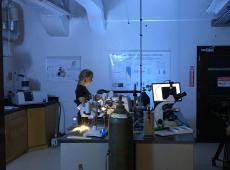Currently, we are using the lab to:
- prepare wood samples for stable carbon isotope analysis to compare water stress levels between trees that survived versus those that died from a recent extreme drought in California
- quantify if fire alters the pit structure of conifer tracheids from branch samples
- quantify phloem and xylem resin ducts for numerous conifer species
This lab is also used to examine the chemical and physical properties of live fuels that contribute to ignitability and combustion behavior. We measure heat content and the relative levels of crude fat, cellulose, hemicellulose and minerals that make up living foliage. Additionally we measure fuel moisture content, relative water content, water potential, density, and surface area, all of which affect whether or how fast a fuel will ignite, and with how much intensity it will burn.
We also examine how fuels decompose upon heating using a thermogravimetric analyzer. This new addition to the lab provides detailed insight into how the different chemical components of a fuel affect how it combusts.
